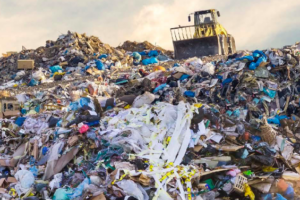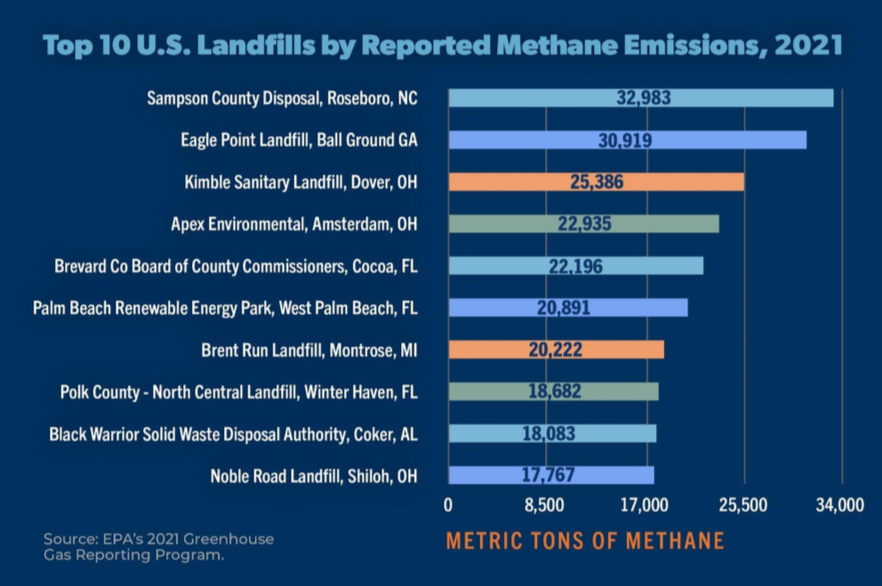
New Report Details Need for Stronger Regulations and Methane Capture Systems at Municipal Landfills. Worst Polluters in NC, GA, OH, FL, MI and AL.
Washington, D.C. – More than 1,100 municipal landfills emitted at least 3.7 million metric tons of methane in 2021, which had the climate-warming impact of 66 million gasoline-powered vehicles driving for a year or 79 coal-fired power plants, according to a new report by the Environmental Integrity Project (EIP).
To reduce this major but little-discussed source of potent greenhouse gases, EPA must impose regulations that mandate more gas-collection systems at landfills, require more monitoring and accurate reporting of methane emissions, and encourage more composting, recycling, and reduction in the waste stream by consumers, according to EIP’s report, “Trashing the Climate: Methane from Municipal Landfills.”
“EPA is failing to adequately control methane from landfills, a huge source of greenhouse gases, and we can no longer ignore this problem with the climate crisis heating up,” said Leah Kelly, Senior Attorney at the Environmental Integrity Project and one of the report’s authors. “Landfills not only contribute to climate change, but they disproportionately impact low-income neighborhoods and communities of color forced to live near dumps.”
One finding from EIP’s report is that municipal waste landfills are often located in communities where residents are people of color or have lower incomes. Fifty-four percent of the landfills reporting to EPA’s greenhouse gas database are surrounded by communities, within a one-mile radius, that exceed national averages for people of color or residents considered low-income.
Methane from food waste, in particular, is a growing problem that needs to be addressed, according to EIP’s report. Americans throw out about 40 percent of their food and the volume of food waste produced in the U.S. increased by a staggering 70 percent between 1990 and 2017.
EIP’s report lists and ranks the 10 landfills that reported releasing the most methane to EPA in 2021, the most recent available year. The biggest polluter was the Sampson County Landfill in Roseboro, North Carolina, about an hour south of Raleigh, which released 32,983 metric tons of methane, more than 10 times the average landfill. Landfills in Georgia, Ohio, Florida, Michigan, and Alabama also rank high on the list.
 Another problem highlighted in EIP’s report is that EPA’s greenhouse gas numbers and information database are not based on pollution monitoring or sampling. Instead, all data on methane and other greenhouse gas emissions from landfills are estimated using mathematical formulas that likely lowball the real numbers.
Another problem highlighted in EIP’s report is that EPA’s greenhouse gas numbers and information database are not based on pollution monitoring or sampling. Instead, all data on methane and other greenhouse gas emissions from landfills are estimated using mathematical formulas that likely lowball the real numbers.
EPA currently requires larger landfills operating since 1980 to estimate their methane emissions using a model, and to report their annual estimates to a national database. But these methods assume that gas control systems and landfill covers function as designed and fail to account for large leaks at landfills that have recently been detected by aerial surveys. EPA on May 5 proposed to revise its methodology to try to account for these gaps, and EIP’s report urges the agency to move forward with reforms to address these problems.
According to EIP’s analysis, Texas and California have the highest methane emissions from landfills, but they also have about twice as many landfills as other states. California regulates landfills more strictly than other states, so has proportionately lower emissions. In comparison, Texas, with weak state regulations, reported about 130,000 more metric tons of methane emissions than California in 2021, despite having added 20 percent less trash to its landfills over the last 10 years. (For a ranking of the top 10 states, see list at bottom.)
The Environmental Integrity Project and allies sued EPA on July 29, 2022, arguing that a set of the agency’s methods for estimating emissions of air pollutants from landfills are outdated, resulting in significant under-reporting. In response, on April 10, 2023, EPA and EIP reached an agreement that requires EPA to review the current defects in methodology used to report landfill methane and if necessary, revise them no later than August 2024.
The Environmental Integrity Project report recommends several solutions to the problem of municipal landfill methane pollution:
- EPA should issue strong new regulations that require more landfills to have methane collection systems and follow better operational standards to make sure these systems really work to reduce pollution.
- EPA should require the direct measurement of methane from landfills through new technology, including ground-based monitors and aerial monitoring systems.
- EPA should improve reporting requirements for landfills across the U.S and establish a uniform method for estimating emissions from dumps.
- The federal government and states should encourage consumers and municipal governments to do more composting and recycling and waste less food.
- Waste incineration should not be considered as a potential solution because it produces toxic air pollutants that tend to harm nearby low-income and minority communities.
For a copy of the report, click here.
Top 10 States by Reported Emissions from Municipal Waste Landfills
| State | Total Reported Emissions (Metric Tons of Methane) | Total Reported Emissions: Tons of Greenhouse Gases (CO2e) | Number of Landfills | % of Landfills with Gas Collection
Systems |
Total Quantity of Waste in Landfills
(Metric Tons) |
| TX | 389,437 | 31,038,131 | 98 | 72% | 1,018,067,371 |
| CA | 260,214 | 20,739,081 | 94 | 96% | 1,575,534,337 |
| FL | 239,792 | 19,111,446 | 46 | 70% | 501,026,912 |
| GA | 188,349 | 15,011,377 | 48 | 65% | 324,600,177 |
| OH | 188,032 | 14,986,119 | 42 | 79% | 522,385,830 |
| MI | 155,552 | 12,397,486 | 49 | 86% | 609,299,295 |
| NC | 148,647 | 11,847,191 | 38 | 74% | 218,322,768 |
| AL | 125,495 | 10,001,980 | 27 | 63% | 157,085,456 |
| IL | 111,627 | 8,896,680 | 54 | 83% | 545,086,364 |
| VA | 110,249 | 8,786,809 | 37 | 70% | 309,660,679 |
Source: EPA’s 2021 Greenhouse Gas Reporting Program. CO2e calculated using the most recent estimate (International Panel on Climate Change Sixth Assessment Report, 20-year global warming potentials).
The Environmental Integrity Project is a nonprofit organization based in Washington, D.C., and Austin, Texas, that is dedicated to enforcing environmental laws and strengthening policy to protect public health and the environment.
###
Media contact: Tom Pelton, Environmental Integrity Project (443) 510-2574 or tpelton@environmentalintegrity.org


